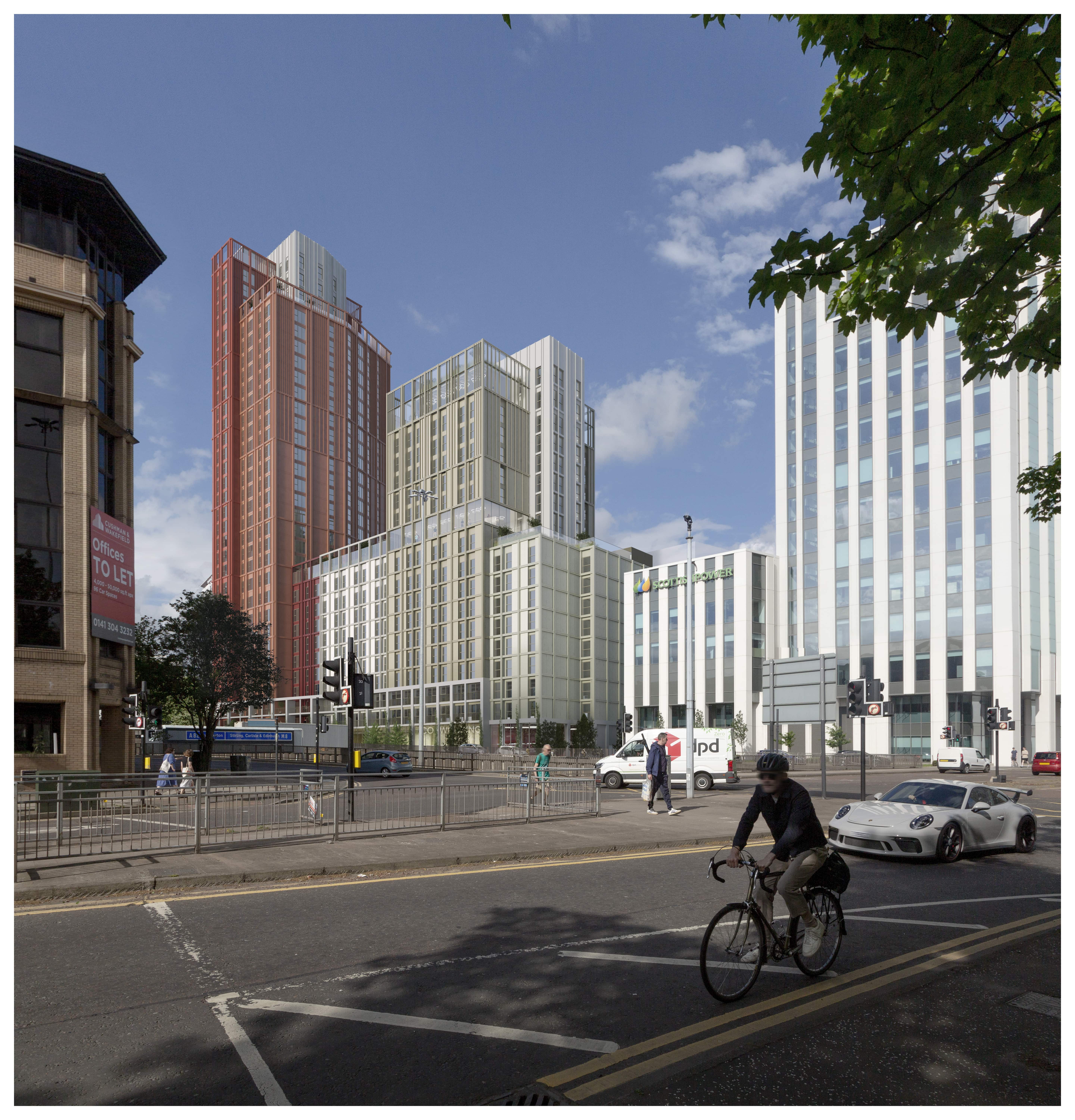Plans lodged for 685 sustainable homes for rent at Portcullis House
Watkin Jones Group has submitted a planning application for a new residential development on the site of Portcullis House at Charing Cross in Glasgow. 
About this development:
- Authority:Glasgow City
- Type:Residential
- Applications:
- Team:Hawkins\Brown Architects (architect), Watkin Jones (developer)
The planning application sees the demolition of the former HMRC building on India Street in favour of a build to rent (BTR) and co-living development of 685 new homes for the city.
This is made up of a 279-unit BTR development to the north of the site, adjacent to Charing Cross Station, and a 406 studio Co-Living development to the south of the site, adjacent to the Scottish Power Building.

Prior to submitting the planning application, Watkin Jones Group, which purchased the site last August, undertook extensive consultation with local representatives, community groups and political representatives.
Iain Smith, planning director for Watkin Jones Group, commented: “We’re thrilled to submit our planning application for this exciting scheme at Portcullis House, regenerating a brownfield site to create sustainable new homes for people in the city. By ensuring there is a good supply of high-quality rented housing in Glasgow we will meet growing demand, which will benefit people across the local area and beyond.
“The design of our proposed homes will help to keep skilled young people in the city who will boost Glasgow’s economy. These people are actively looking for a sustainable and desirable place to live in central location with excellent transport links and places to shop or socialise. This will repopulate the city centre and benefit local businesses as part of an overall renewal of the west end.

“Build to rent and co-living developments are built for the long-term, so our focus is on creating a great place to live for decades with high-quality rented accommodation at competitive prices that appeal to a wide range of people. There is huge demand in Glasgow for these homes, which offers long-term security of tenure, combined with the flexibility of renting.”
Contributing to the ongoing regeneration of Glasgow’s city centre, the delivery of much-need high-quality rental housing and increased investment has also received the endorsement of the Glasgow Chamber of Commerce.
Stuart Patrick, chief executive of Glasgow Chamber of Commerce, said: “It is fantastic to be seeing this level of investment being made in Glasgow. Delivering high-quality housing such as this, which is desperately needed, will address increasing demand. It will also serve to retain skilled young people in the city as well as regenerating the city centre, which is a key aspiration for the city council.

“Glasgow City Council’s City Centre Living Strategy outlines a target to double the city centre’s population to 40,000 over the next 15 years and increasing density in the city centre is essential to its long-term success and sustainability. Schemes such as this do exactly that.
“The site has excellent transport links and local businesses will clearly benefit from these proposals. Innovative developments such as this are to be greatly welcomed.”
Build to rent and co-living business models mean that homes are designed to add value to a community so that the building and wider area remain desirable for decades. An emphasis is put on high-quality design that fully embraces the Placemaking Principles endorsed by Glasgow Council.

There is extremely strong demand for these homes in the city centre, providing high-quality rental accommodation in a highly sustainable location, delivering much needed places to rent with easy access to transport links, amenities and places of work.
Designed to the highest environmental standards, including the use of low and zero carbon technologies such as heat pumps and low energy lighting, it will support new economic and social opportunities (potentially including retail, food and drink, office and leisure). In view of the highly sustainable location of the site, its accessibility by public transport and pedestrian/cycle routes, and the proximity of the multi-storey car park on Elmbank Crescent, no on-site parking for residents is proposed.
The public will be able to enjoy the top floor of the development, which will be available through a booking system. This will help to bring the community together with the attraction of high quality community space with stunning views in this part of Glasgow. The redevelopment of the brownfield site will form a significant part of an overall renewal of the west end of the city centre, acting as a catalyst for change. Proposals are also fully in line with Glasgow City Council’s City Centre Living Strategy which outlines a target of doubling the city centre’s population to 40,000 over the next 15 years.

Glasgow has however fallen behind other major cities such as Manchester, Birmingham and Liverpool in repopulating its centre and such a development will meet increasing demand, keeping people in and attracting them to the city.
As living space becomes more important post-pandemic, Portcullis House will ensure the city remains economically competitive with other large cities in the UK which can offer similar high quality residential development. Furthermore, it will support graduate retention and ensure Glasgow remains an attractive city for young professionals.
Not only that but the new residential community aims to support the local economy and help enhance the vitality of this part of Glasgow.
The Portcullis House scheme has been designed by architect Hawkins Brown’s local office in Glasgow, which has a good track record in the city. The practice received consent proposal for a 4-star hotel at St Vincent Street and is also currently masterplanners for the regeneration of Custom House Quay and Carlton Place for Glasgow City Council.























